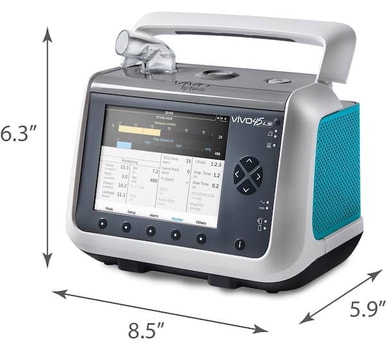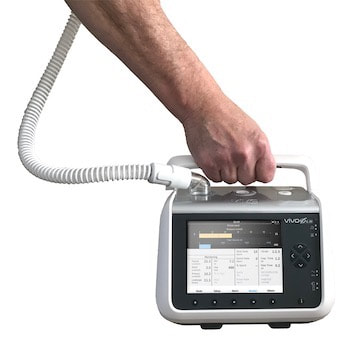What you need to know
|
Weighing just 5.3 pounds and measuring just 8.5 x 6.3 x 5.9 inches, the Vivo 45 LS is one of the smallest life-support ventilators on the market. Its ultra-compact design maximizes mobility and independence for people living with ALS.
The Vivo 45 LS’s patented eSync patient breath-trigger technology provides patient comfort by adjusting to air-flow changes on a breath-by-breath basis. It also recognizes and quickly accommodates air leaks around a mask or tracheostomy, which can minimize sudden, uncomfortable auto-triggering. |
You can use the Vivo 45 LS for breathing support at night in bilevel mode, intermittent breathing support during the day in sip-and-puff mode, or as a full-time life support ventilator after a tracheostomy.
Additional information:
Additional information:
- The Vivo 45 LS is whisper quiet—under 30 decibels.
- It is the only home ventilator that has integrated carbon dioxide monitoring.
- You can use mouthpiece ventilation, masks, and tracheostomy interfaces.
- It is the only home ventilator with an easy-to-use, space-saving internal click-in NIV (mask) humidifier* with a heated wire circuit*.
- You can navigate the color screen using physical menu buttons and then press the information button whenever you need more context or information.
- The built-in internal battery lasts 2 hours and the internal click-in/hot-swap battery lasts 5.5 hours. The batteries will charge whenever your ventilator is plugged into the wall.
- Adding the Xpac by Breas external battery will extend battery life by another 18 hours, for a total of 25.5 hours when used together with the internal and click-in batteries.
- The ventilator’s cloud-based, remote-monitoring system, EveryWare by Breas, provides insights that can help professionals monitor and improve care.
- High Flow Nasal Therapy* treatment option for patients with NIV intolerance (requires use of an external humidifier**)
Weight: 5.3 lbs with 2-hour built-in internal battery (6.8 lbs with click-in/hot-swap battery)
Dimensions: 8.5 x 6.3 x 5.9 inches
Includes: One internal click-in/hot-swap battery and power cord. Masks, interfaces, mouthpieces, and portable carry case should be included and delivered by the DME company.
Dimensions: 8.5 x 6.3 x 5.9 inches
Includes: One internal click-in/hot-swap battery and power cord. Masks, interfaces, mouthpieces, and portable carry case should be included and delivered by the DME company.
“I like that it’s small and lightweight. I like that it’s quiet. With Vivo, I feel like it’s there breathing with me. We’re on the same page. It’s taking cues from me and yet giving me what it’s been programmed to do as well.”
– Dr. Carol Gill, Professor Emeritus, Disability and Human Development, Breas Vivo 45 LS user
“With a change to a Vivo ventilator, the leaks no longer affect the treatment. Some patients no longer need a full face mask. They can be ventilated using a nasal mask or even a nasal cannula. They still maintain the carbon dioxide levels that indicate they are being properly ventilated.
Patients tell us, ‘When I’m on this machine, I feel like I’m not so tired anymore.’ They have to work so hard to overcome the asynchrony from other machines that it’s really difficult to breathe sometimes and they have to work so hard to get the air. With the Vivo, breathing is much easier. I believe that if I put a patient on a Vivo, you’ll definitely have a better chance to have a better quality of life.”
– Jorge Bolano, Respiratory Therapist, Home Respiratory Care Provider
– Dr. Carol Gill, Professor Emeritus, Disability and Human Development, Breas Vivo 45 LS user
“With a change to a Vivo ventilator, the leaks no longer affect the treatment. Some patients no longer need a full face mask. They can be ventilated using a nasal mask or even a nasal cannula. They still maintain the carbon dioxide levels that indicate they are being properly ventilated.
Patients tell us, ‘When I’m on this machine, I feel like I’m not so tired anymore.’ They have to work so hard to overcome the asynchrony from other machines that it’s really difficult to breathe sometimes and they have to work so hard to get the air. With the Vivo, breathing is much easier. I believe that if I put a patient on a Vivo, you’ll definitely have a better chance to have a better quality of life.”
– Jorge Bolano, Respiratory Therapist, Home Respiratory Care Provider
Where can I get one?
The Vivo 45 LS should be covered by Medicare and private insurance. When your neurologist or pulmonologist writes a prescription and provides documentation for your need for a ventilator, you can ask about getting a Vivo 45 LS.
A durable medical equipment (DME) company will process your order and deliver the ventilator to your home, where you will receive training from a respiratory therapist on how to set up and use your device. If you get a tracheotomy, you and your caregivers will be trained in the hospital before going home.
A durable medical equipment (DME) company will process your order and deliver the ventilator to your home, where you will receive training from a respiratory therapist on how to set up and use your device. If you get a tracheotomy, you and your caregivers will be trained in the hospital before going home.
For over 30 years, Breas has delivered a comprehensive line of respiratory medical devices to patients around the world. The market leader in Europe, Breas is known for its Swedish design, reliable technology, and ease of use. The Vivo 65 ventilator was 510(k) cleared by the FDA in 2016. The smaller Vivo 45 LS, based on proven Vivo 65 technology, became available in the US in early 2021.
*Modification in accordance with FDA's guidance. Enforcement Policy for Ventilators and Accessories and Other Respiratory Devices During the Coronavirus Disease 2019 (COVID-19) Public Health Emergency.
**Heated Humidified High Flow Nasal Cannula in ALS: Salvage Therapy for NPPV Intolerance M. Barash, A.L. Anton, J. Shah 1
**Heated Humidified High Flow Nasal Cannula in ALS: Salvage Therapy for NPPV Intolerance M. Barash, A.L. Anton, J. Shah 1
Learn more at Your ALS Respiratory Guide
Your ALS Guide carefully selects a limited number of products to feature. Most have been recommended by ALS professionals and used by ALS patients. In exchange for featured product pages, equipment manufacturers support our website, which enables us to develop more educational content for you.






